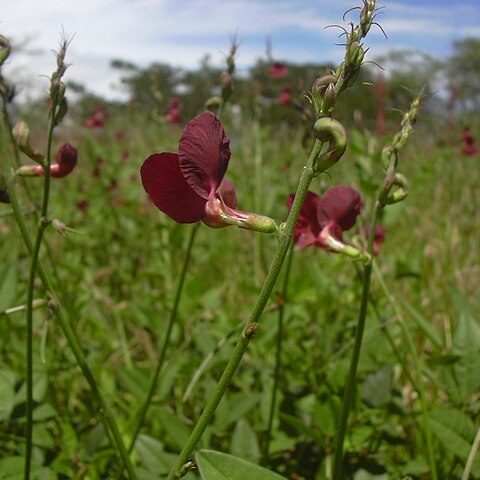peduncles, the flowers mostly congested at the apex; bracteoles narrow, at least distally, nervate, caducous, rachis with small swellings at the nodes, lacking extrafloral nectaries; pedicels equalling or shorter than the calyx. Flowers pur-plish, red, violet, or white, the interior often vivid; calyx campanulate, the teeth free, the upper 2 teeth sometimes reduced; standard orbicular, emarginate, with 2 small basal auricles, lacking median thickenings; wings longer than the standard and the keel, long stipitate, the keel petals apically spiralled, basally adnate to the staminal tube; style apically recurved and thickened, caducous. Legume lin-ear, turgid or compressed, non septate; seeds numerous, small with a short hilum.
Vines or sometimes erect or sprawling herbs, sometimes perennial from a thick rootstock. Leaves pinnate trifoliolate or rarely unifoliolate; leaflets glabrous or pubescent but lacking uncinate hairs, stipels ciliate to tomentose; stipules nervate, not prolonged below the insertion. Inflorescences with stiff, elongate
Ovary linear, with numerous ovules; style tenuous below, filiform and flexible, the apical part cartilaginous and thickened, abruptly curved through 90° just above its junction with the tenuous part, narrowed and slightly curved towards the apex, resembling a squarish hook, hairy inside towards the terminal stigma.
Standard broad, reflexed, without appendages; wings broadly rounded; keel with a long claw adnate to the staminal sheath, the blade rather narrow, elongated, the apex beaked and forming a spiral of 270º, shorter than the wings.
Inflorescences axillary, falsely racemose, long-pedunculate, the flowers in fascicles along the rhachis which is swollen at the insertion of the pedicels; bracts and bracteoles present, deciduous or ± persistent.
Leaves pinnately 3-foliolate; stipules subpersistent, not prolonged below the point of insertion, striate; stipels present.
Flowers usually fairly small, white or red to blackish-purple.
Calyx 5-lobed; upper lobes joined higher.
Vexillary stamen free; anthers uniform.
Pods long and narrow, many-seeded.
Seeds small, with a short hilum.
Herbs, prostrate or twining.

